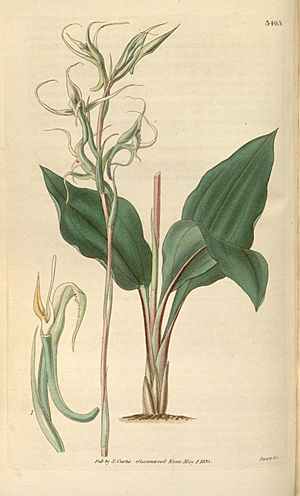Longclaw orchid facts for kids
Quick facts for kids Longclaw orchid |
|
|---|---|
 |
|
| 1835 illustration | |
| Scientific classification | |
| Genus: |
Eltroplectris
|
| Species: |
calcarata
|
| Synonyms | |
|
|
The Eltroplectris calcarata, also known as the longclaw orchid, is a special type of orchid. Unlike many orchids that grow on trees, this one is a terrestrial species. This means it grows directly in the ground, like most other plants you know.
This beautiful orchid is found in many warm places. It grows naturally in Florida, the Bahamas, and the Cayman Islands. You can also find it in Cuba, Hispaniola, Jamaica, and Puerto Rico. Further south, it lives in the Windward Islands, Trinidad, Suriname, Venezuela, Colombia, Peru, Brazil, and Paraguay.
Contents
Discovering the Longclaw Orchid
The longclaw orchid gets its name from its unique shape. The word "calcarata" in its scientific name refers to a spur-like part of the flower. This part often looks like a long claw or a hook. Orchids are known for their amazing and sometimes unusual flower shapes.
What Makes Orchids Special?
Orchids are one of the largest families of flowering plants. There are tens of thousands of different orchid species. They are famous for their colorful and often fragrant flowers. Many orchids have a special relationship with tiny fungi in the soil. These fungi help the orchid roots absorb nutrients.
Terrestrial Orchids: Growing in the Ground
Most people think of orchids growing on trees. These are called epiphytic orchids. But the longclaw orchid is terrestrial. This means its roots grow in the soil. It gets water and nutrients directly from the ground. This makes it similar to many common garden plants.
Where the Longclaw Orchid Thrives
The longclaw orchid prefers warm, humid climates. Its wide native range shows it can adapt to different environments. It often grows in forests or woodlands where there is some shade. The soil needs to be well-drained but still moist.
Its Home Across the Americas
From the southern United States to South America, the longclaw orchid has a large natural habitat.
- In North America, it's found in Florida.
- It's common throughout the Caribbean islands.
- In South America, it spreads across many countries.
This wide distribution shows how resilient this plant can be.
The Life Cycle of an Orchid
Orchids have an interesting life cycle. They start as tiny seeds. These seeds are so small they look like dust. They need special conditions to sprout.
How Longclaw Orchids Reproduce
Like most flowering plants, longclaw orchids reproduce using seeds. Their flowers are designed to attract pollinators. These pollinators, often insects, help carry pollen from one flower to another. After pollination, the flower develops a seed pod. When the pod opens, the tiny seeds are released. They are then carried by the wind to new places. If they land in a good spot, they can start to grow.
A Plant's Journey from Seed to Flower
The journey from a tiny seed to a full-grown flowering orchid takes time. Young orchids, called seedlings, need to establish a strong root system. They grow leaves to capture sunlight. Once they are mature enough, they will produce their own beautiful flowers. This cycle repeats, ensuring new generations of longclaw orchids.
Images for kids


